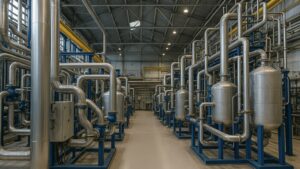A major element of decarbonization will be adjusting and modifying energy-based emissions. Businesses and entire countries need to approach where and how they power their operations with a strategic plan to hit net-zero carbon emissions in the near future. This means understanding what natural sources an area has and how best to use them. The UK is a great example of offshore wind, with a breezy climate and ample coastline.
Why is sustainable energy needed?
A significant part of carbon emissions is the CO2 that gets pumped into our atmosphere through energy production. Fossil fuels are efficient but have all sorts of negative effects on the environment and the carbon in our atmosphere in particular. As companies are pushed to reduce their emissions across all three scopes, energy remains a significant concern. As a result, renewable energy is the new player in town and should be embraced to power the globe over the coming decade. Solar, wind, and hydropower all have their own nuances and are more feasible in different areas. So let’s take a look at one promising example in the UK.
Offshore wind farms?
A wind farm is simple enough, turbines that are spun by, you guessed it, the wind to generate electricity. One often finds them by the sea, where average wind speeds tend to be higher. Engineers and scientists have come to the realization that if these turbines are placed off the coast, they can get more consistent output without taking up space near residential areas.
With its long, winding coastline and North Atlantic position, the UK has the largest wind energy capacity in the world. Many of these turbines are located miles from shore where they are under near-constant wind pressure, powering the homes and businesses of thousands. Over the coming decade, it might become the primary energy source for the nation, massively cutting emissions. These days, offshore wind turbines might come in a variety of shapes. Some are fixed structures with foundations below the water line, while others are actually buoys and can move and turn to find the best position.
What are the implications?
Despite its utility, offshore wind power isn’t a good solution for much of the world. Landlocked nations or ones with limited coastlines won’t be able to benefit from this form of wind power. But this serves as an example of a nation that understood its natural advantages and exploited them.
Companies in sunny areas should consider the use of solar power, while dams and hydropower are great options in other locations. More importantly, this serves as evidence that sustainable energy could be embraced quickly and effectively even in an economy as developed as the UK. Companies should adjust their carbon strategies accordingly and start exploring what sustainable solutions might be right for them. Industry leaders need to learn from each other to make the best of these opportunities.
The “Climate & Legal Risk Summit: Navigating Sustainability in Energy & Mining” summit is a two-day event that brings together leading legal professionals from the energy and extractive industries for a unique opportunity to learn from and network with their peers. It will be held in Amsterdam, NL, on June 5th-6th, 2023. Visit future-bridge.eu and netzero-events.com or follow us on our social media to track other energy use and decarbonization events.





